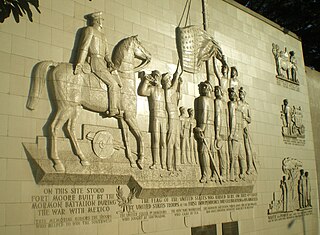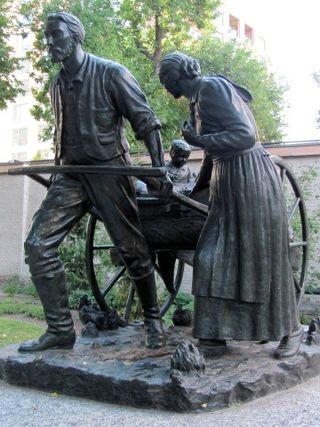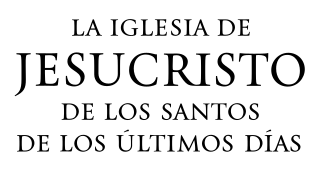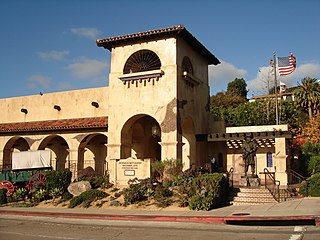
The Mormon Battalion was the only religious unit in United States military history in federal service, recruited solely from one religious body and having a religious title as the unit designation. The volunteers served from July 1846 to July 1847 during the Mexican–American War of 1846–1848. The battalion was a volunteer unit of between 534 and 559 Latter-day Saint men, led by Mormon company officers commanded by regular U.S. Army officers. During its service, the battalion made a grueling march of nearly 2,100 miles from Council Bluffs, Iowa, to San Diego, California.

The Mormon Trail is the 1,300-mile (2,100 km) long route from Illinois to Utah on which Mormon pioneers traveled from 1846–47. Today, the Mormon Trail is a part of the United States National Trails System, known as the Mormon Pioneer National Historic Trail.

The Mormon pioneers were members of the Church of Jesus Christ of Latter-day Saints, also known as Latter-day Saints, who migrated beginning in the mid-1840s until the late-1860s across the United States from the Midwest to the Salt Lake Valley in what is today the U.S. state of Utah. At the time of the planning of the exodus in 1846, the territory was part of the Republic of Mexico, with which the U.S. soon went to war over a border dispute left unresolved after the annexation of Texas. The Salt Lake Valley became American territory as a result of this war.
Levi Savage Jr. is a prominent figure in the history of The Church of Jesus Christ of Latter-day Saints. He was one of the LDS Church's earliest missionaries to Asia and was one of the leaders of the Mormon pioneers traveling in the Willie Handcart Company.
In the Book of Mormon, the Three Nephites are three Nephite disciples of Jesus who were blessed by Jesus to remain alive on the earth, engaged in his ministry and in their apostolic callings until his Second Coming. As described in Third Nephi chapter 28, this change occurred when they were caught up into heaven. Similar to Mormon beliefs about John the Apostle, the Three Nephites were granted immortality in order to carry out their ministering work on the earth. The account in the Book of Mormon reads that they ministered unto all the people in the surrounding lands, bringing many to the church by means of preaching and baptism.

The Mormon corridor are the areas of western North America that were settled between 1850 and approximately 1890 by members of the Church of Jesus Christ of Latter-day Saints, who are commonly called "Mormons".

The Fresno California Temple is the 78th operating temple of the Church of Jesus Christ of Latter-day Saints.

The Ciudad Juárez Mexico Temple is the 71st operating temple of the Church of Jesus Christ of Latter-day Saints.

The San Diego California Temple is the 47th constructed and 45th operating temple of the Church of Jesus Christ of Latter-day Saints. Located near the La Jolla community of San Diego, it was built with two main spires, but unique to this temple are four smaller spires at the base of each main spire. The East spire is topped with the familiar Angel Moroni statue which adorns many Latter-day Saint temples.

The Church of Jesus Christ of Latter-day Saints in California refers to the Church of Jesus Christ of Latter-day Saints and its members in California. California has the 2nd most members of the LDS Church in the United States, behind Utah. The LDS Church is the 2nd largest denomination in California, behind the Roman Catholic Church.

The Church of Jesus Christ of Latter-day Saints has had a presence in Mexico since 1874. Mexico has the largest body of LDS Church members outside of the United States. Membership grew nearly 30% between 2011 and 2021. In the 2010 Mexican census, 314,932 individuals self-identified most closely to the LDS Church.

The Church of Jesus Christ of Latter-day Saints in Colorado refers to the Church of Jesus Christ of Latter-day Saints and its members in Colorado. The first congregation of the Church in Colorado was organized in 1897. It has since grown to 148,708 members in 310 congregations.
The Third Convention was a dissident group of Mexican Latter-day Saints (Mormons) who broke away from the main body of church authority in 1936 over a dispute about local governance and autonomy of the Church of Jesus Christ of Latter-day Saints in Mexico.

The Church of Jesus Christ of Latter-day Saints in New Mexico refers to the Church of Jesus Christ of Latter-day Saints and its members in New Mexico. The first congregation of the Church in New Mexico was organized in 1895. It has since grown to 69,055 members in 137 congregations.

The Tijuana Mexico Temple is a temple of the Church of Jesus Christ of Latter-day Saints in Tijuana, México. Completed in 2015, the intent to construct the temple was announced by church president Thomas S. Monson on October 2, 2010, during the church's semi-annual general conference. It is the thirteenth temple built in Mexico.

The Hartford Connecticut Temple is a temple of the Church of Jesus Christ of Latter-day Saints in Farmington, Connecticut. It is the first LDS temple in Connecticut and the second in New England, following the Boston Massachusetts Temple.
The name of the Church of Jesus Christ of Latter-day Saints is derived from an 1838 revelation church founder Joseph Smith said he received. Church leaders have long emphasized the church's full name, and have resisted the application of informal or shortened names, especially those which omit "Jesus Christ". These informal and shortened names include the "Mormon Church", the "LDS Church", and the "Church of the Latter-day Saints".

The following outline is provided as an overview of and a topical guide to the Church of Jesus Christ of Latter-day Saints.

For the monument in New Mexico, see Mormon Battalion Monument.

The Mormon Battalion Historic Site is a historic site in Old Town, San Diego, California, built in honor of the members of the Church of Jesus Christ of Latter-day Saints who served in the United States Army's Mormon Battalion during the Mexican–American War of 1846–1848. The battalion was stationed in Old Town in 1847, during which they participated in many civic improvement projects.


















